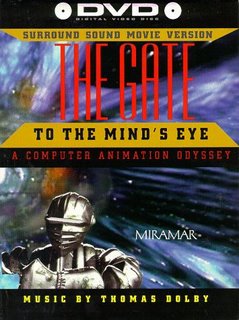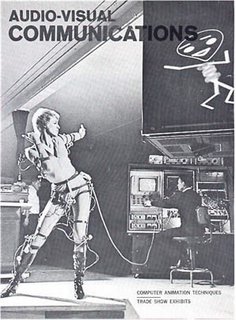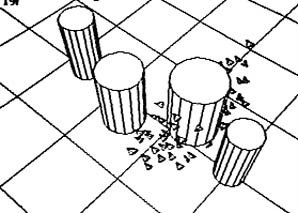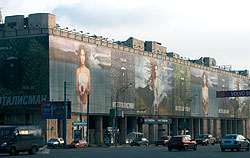Computerized Visual Imagery
Today computer animation [CGI] is pretty much taken for granted. Its overuse, especially in movie affects, have all but numbed viewers to this new medium. However, its not that long ago that CGI didn't exist, much less enable visualization of content and process no one had ever dreamed of.
My education in Graphic Arts introduced me to artistic usage of computers at an early age. But even before that, I'd interacted with them in junior high using a VIC120 with an attached cassette tape drive [before floppies], and again in high school, when I wrote simple programs to print my class papers using a Commodore 64 instead of the then standard typewriter. Computers in the 70s and early 80s were dull, lacked visual processing, and interaction consisted mostly of text inputting for program runs. Although I liked computers, they didn't exactly throttle my artistic imagination.
During those formittable years my most interesting computer experiences occurred at the local video arcade or at friend's houses playing Atari. Defender, Space Invaders, and Centipede were three of my most favorite games.
In college I used early IBM PS2 computers, Amigas, and an early form of CAD to digitally render art projects for classes. Those were the days before Mac, and the processin' was slow. Scanning input took place using pole-mounted CCD cameras, printing was prohibitively expensive, and most classwork was presented by photographs of screen images converted to slides. I still have some in my closet.
On the other hand, once I began working I was introduced to Magna, Novel Networks, PageMaker, Photoshop, Illustrator, and the world of the visually intuitive Mac computer. During the 80s the Graphic Art industry underwent a chaotic disassembly and reorganization fueled by the promise of computer graphic art. Those were crazy times. Many Art Directors of the day couldn't conceive computers replacing their "art". These shortsighted individuals eventially lined unemployment offices everywhere. Those of us who realized computers could enhance and expand our profession embraced the new technology and began experimenting, applying, rethinking, and reinventing the profession. The Graphic Arts upheaval was a precursor to the disintermediation taking place now in music, publishing, and media, courtesy of the WWW.
I saw Tron, marvelling at this early CGI attempt. Although the movie 2001 contained wireframed computer images I was disappointed to find that when Kubric made the movie [1965-67] this technology didn't exist and he instead produced conventional analog animations that mimicked what he thought computers would render.
CGI became increasingly intermixed with our culture's visual experience during the 1980s. TV commercials embraced CGi to create eye-popping visuals and save time and money. This early exposure to CGI began fueling the public's expectations of computer graphics, pushing the leading CGI artists to their limits.
In the early 1990s, before Jurassic Park and Toy Story, I purchased 2 CGI VHS tapes:


I was blown away by these two 'movies'. The CGI clips came from leading animators across the field, there was nothing like these anywhere else at that time. There is also an earlier Mind's Eye produced in 1990. All three art available on Amazon as DVDs.
I wondered where the clips came from for these VHS tapes. I played them many, many times, totally obsessed with the lush colors, smooth animation, and mind-blowing images these computer artists created. And now, thanks to the web, I know why these were produced and by whom. Many of the movies used in the Mind's Eye videos are linked at a new site by OSU.
Ohio State University's website contains an indepth online history of computer graphics and animation, sitelink is here. A Critical History of Computer Graphics and Animation is a website designed to accompany Industrial, Interior and Visual Communications Design #797/Arts College 732, Winter 05.
The site is filled with intriguing still images, but what sets it apart from other histories is its use of Quicktime movies--video samples of even the earliest computer graphics--which more richly display CGI evolution than any words could explain.

I never knew there were serious attempts at analog computer animation, using vacuum tube computers as this image explains.
Among the most interesting sections are those dedicated to the computational complications encountered along the way.
One of the sessions I attended at the recent AAA meeting contained presentations by NASA and computer intelligence Anthropologists working on current problems. One of the presenters works at an AI thinktank and discussed the accomplishments of Craig Reynolds in the 1980s. I wanted to learn more. The Ohio State site discusses his AI work in great detail:


Another topic this site goes into in great detail is the discovery of fractals and their contribution to CGI. The illustration above is a Mandelbrot fractal. Mandelbrot was a French mathematician who's imagination and foresight let to the computer visualization of fractals.
My education in Graphic Arts introduced me to artistic usage of computers at an early age. But even before that, I'd interacted with them in junior high using a VIC120 with an attached cassette tape drive [before floppies], and again in high school, when I wrote simple programs to print my class papers using a Commodore 64 instead of the then standard typewriter. Computers in the 70s and early 80s were dull, lacked visual processing, and interaction consisted mostly of text inputting for program runs. Although I liked computers, they didn't exactly throttle my artistic imagination.
During those formittable years my most interesting computer experiences occurred at the local video arcade or at friend's houses playing Atari. Defender, Space Invaders, and Centipede were three of my most favorite games.
In college I used early IBM PS2 computers, Amigas, and an early form of CAD to digitally render art projects for classes. Those were the days before Mac, and the processin' was slow. Scanning input took place using pole-mounted CCD cameras, printing was prohibitively expensive, and most classwork was presented by photographs of screen images converted to slides. I still have some in my closet.
On the other hand, once I began working I was introduced to Magna, Novel Networks, PageMaker, Photoshop, Illustrator, and the world of the visually intuitive Mac computer. During the 80s the Graphic Art industry underwent a chaotic disassembly and reorganization fueled by the promise of computer graphic art. Those were crazy times. Many Art Directors of the day couldn't conceive computers replacing their "art". These shortsighted individuals eventially lined unemployment offices everywhere. Those of us who realized computers could enhance and expand our profession embraced the new technology and began experimenting, applying, rethinking, and reinventing the profession. The Graphic Arts upheaval was a precursor to the disintermediation taking place now in music, publishing, and media, courtesy of the WWW.
I saw Tron, marvelling at this early CGI attempt. Although the movie 2001 contained wireframed computer images I was disappointed to find that when Kubric made the movie [1965-67] this technology didn't exist and he instead produced conventional analog animations that mimicked what he thought computers would render.
CGI became increasingly intermixed with our culture's visual experience during the 1980s. TV commercials embraced CGi to create eye-popping visuals and save time and money. This early exposure to CGI began fueling the public's expectations of computer graphics, pushing the leading CGI artists to their limits.
In the early 1990s, before Jurassic Park and Toy Story, I purchased 2 CGI VHS tapes:


I was blown away by these two 'movies'. The CGI clips came from leading animators across the field, there was nothing like these anywhere else at that time. There is also an earlier Mind's Eye produced in 1990. All three art available on Amazon as DVDs.
I wondered where the clips came from for these VHS tapes. I played them many, many times, totally obsessed with the lush colors, smooth animation, and mind-blowing images these computer artists created. And now, thanks to the web, I know why these were produced and by whom. Many of the movies used in the Mind's Eye videos are linked at a new site by OSU.
Ohio State University's website contains an indepth online history of computer graphics and animation, sitelink is here. A Critical History of Computer Graphics and Animation is a website designed to accompany Industrial, Interior and Visual Communications Design #797/Arts College 732, Winter 05.
The site is filled with intriguing still images, but what sets it apart from other histories is its use of Quicktime movies--video samples of even the earliest computer graphics--which more richly display CGI evolution than any words could explain.

I never knew there were serious attempts at analog computer animation, using vacuum tube computers as this image explains.
Among the most interesting sections are those dedicated to the computational complications encountered along the way.
One of the sessions I attended at the recent AAA meeting contained presentations by NASA and computer intelligence Anthropologists working on current problems. One of the presenters works at an AI thinktank and discussed the accomplishments of Craig Reynolds in the 1980s. I wanted to learn more. The Ohio State site discusses his AI work in great detail:

A variation of the particle system was used by Craig Reynolds to model the flocking and schooling behavior of birds and fish. In this particle system the particles are used to represent what Reynolds called "boids". In this case, each particle is an entire polygonal object rather than a graphical primitive, each particle has a local coordinate system, and there are a fixed number of particles that are not created or destroyed. The attributes which control the boids behavior is dependent on external as well as internal conditions, allowing a boid particle to react to what other particles are doing around it. Some characteristics of this system include:
. Collision avoidance - a boid is constrained from colliding with other boids or obstacles;
. Velocity matching - each boid attempts to go the same speed and direction as neighboring boids;
. Flock centering - each boid attempts to stay close to nearby flockmates.
According to Reynolds:
Typical computer animation models only the shape and physical properties of the characters, whereas behavioral or character-based animation seeks to model the behavior of the character. The goal is for such simulated characters to handle many of the details of their actions, and hence their motions. These behaviors include a whole range of activities from simple path planning to complex "emotional" interactions between characters. The construction of behavioral animation characters has attracted many researchers, but it is still a young field in which more work is needed.
Reynolds' 1986 computer model of coordinated animal motion was based on three dimensional computational geometry. The flocking model placed an individual "boid" in a flock, and determined the motion path using the steering behaviors that were based on the positions and velocities nearby flockmates:
. Separation: steer to avoid crowding local flockmates
. Alignment: steer towards the average heading of local flockmates
. Cohesion: steer to move toward the average position of local flockmates
Each boid has direct access to the whole scene's geometric description, but it needs to react only to flockmates within a certain small neighborhood around itself. The neighborhood is characterized by a distance (measured from the center of the boid) and an angle, measured from the boid's direction of flight. Flockmates outside the local neighborhood are ignored.

Another topic this site goes into in great detail is the discovery of fractals and their contribution to CGI. The illustration above is a Mandelbrot fractal. Mandelbrot was a French mathematician who's imagination and foresight let to the computer visualization of fractals.
A fractal is a rough or fragmented geometric shape that can be subdivided in parts, each of which is (at least approximately) a reduced-size copy of the whole. Fractals are generally self-similar and independent of scale, that is they have similar properties at all levels of magnification or across all times. Just as the sphere is a concept that unites physical objects that can be described in terms of that shape, so fractals are a concept that unites plants, clouds, mountains, turbulence, and coastlines, that do not correspond to simple geometric shapes.This website is a fascinating tour of CGI history not to be missed by anyone interested in modern visual imagery. Check it out. You may come away with a an expanded perspective and new appreciation of computer graphics. Again, sitelink is here.
According to Mandelbrot,
"I coined fractal from the Latin adjective fractus. The corresponding Latin verb frangere means "to break" or to create irregular fragents. It is therefore sensible - and how appropriate for our needs - that, in addition to "fragmented" (as in fraction or refraction), fractus should also mean "irregular," both meanings being preserved in fragment." _(The Fractal Geometry of Nature, page 4.)




